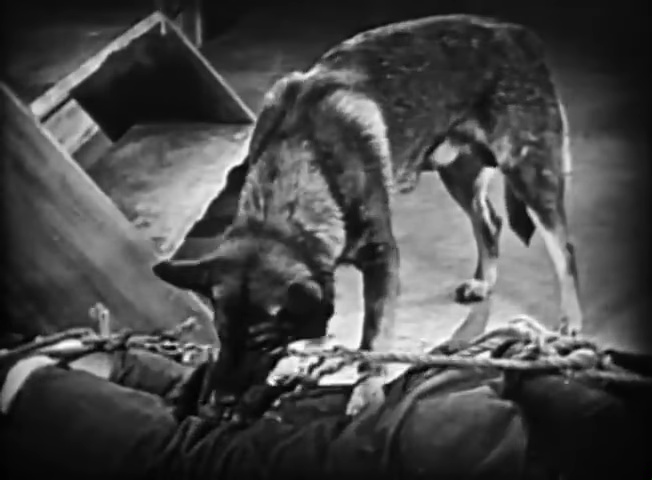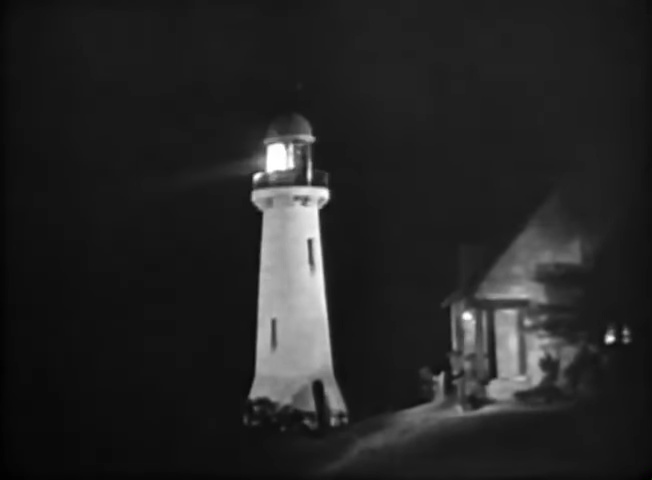An elderly lighthouse keeper is losing his eyesight and with it, his job. The local townsfolk are all in cahoots with a gang of smugglers, so there seems to be nobody to take his place… until a castaway and his dog wash ashore.
Home Media Availability: Released on DVD.
Who’s the good lighthouse keeper?
Silent era film studios had been operating on the programmer-special principle since the dawn of the feature-length era. Basically, mid- to low-budget, reliable pictures would be regularly released to assure a steady income stream, which could then be used for big budget, big prestige “specials.”
Westerns were popular entries in this category, as well as flapper pictures, melodramas and light comedies. Warner Bros. had an ace in the hole in this regard and he had pointed ears and a bushy tail. Rin-Tin-Tin was not the first animal star or even the first German Shepherd film star but he was certainly the biggest. Rinty films essentially printed money for the studio and financed bigger ambitions. The pictures were decently but not lavishly budgeted and easily earned back the investment several times over. Woof woof!
The Lighthouse by the Sea concerns elderly lighthouse keeper Caleb Gale (Charles Hill Mailes). He is losing his eyesight, which means he will have to give up his post once his condition becomes known to his employers. His daughter, Flora (Louise Fazenda), has been covering for him and keeping the lighthouse in good working order without a single shipwreck. Why not just give her the job? That’s silly talk, she’s a girl!
Revenue agents are relying on the lighthouse to help them capture bootleggers operating in the vicinity and the ringleader of the gang, Joe Daggett (Matthew Betz), is just as determined to make sure its light is extinguished when they bring their boozy cargo ashore. It looks like Caleb and Flora are an easy target for the gang…
But then two castaways wash up on the beach: Rin-Tin-Tin, veteran Red Cross war dog who served in France, and Albert Dorn (William “Buster” Collier Jr., his character renamed “Bob” in the 16mm release), a human. Flora finds Albert on the beach. Rin-Tin-Tin finds Joe and has a nice munch on his legs just to show the bully who’s boss.
The rest of the film is pretty typical dog melodrama fare with Joe scheming and kidnapping assorted members of the cast in turn as he tries to deliver his booze and Albert being pretty much useless but who needs him when we have Rin-Tin-Tin.
As usual in Rinty pictures, the dog steals the show. Rin-Tin-Tin was cute but not a classically beautiful German Shepherd. What he lacked in show dog looks, though, he more than made up for in personality and acting ability. He projected emotions for the camera beautifully and his tricks come across as natural and not just a dog obeying offscreen cues.
I am afraid that I fell into the trap that many fans of comedians find themselves in when their favorites take a serious role. I love Louise Fazenda as a comedian, but Flora is just a standard “the Girl” role, so she doesn’t have much to do besides act upset and take her turn being kidnapped. If you’re going to not let Fazenda be funny, at least give her something interesting to do.
I don’t have such strong opinions about Collier and Mailes as actors (but shoutout to Mailes for being Mr. Claire McDowell) and they do fine in their “second fiddle to the furry Alsatian) roles. I don’t feel there was as big of a lost opportunity.
This opinion was shared by the Photoplay reviewer, who stated: “When the human players fail to boost the yarn along, enter Rin-Tin-Tin, who, after persistent endeavor, swoops an old fashioned melodrama to a smashing good finish.”
Warner Bros. collaborated with the Matilda Ziegler Magazine for the Blind to advertise a special New York screening of the picture. 1,000 people arrived at the Piccadilly Theatre and the film was presented with a special orchestra score and spoken descriptive narration delivered by a professional actor. Four songs selected to heighten the mood were performed by operatic soprano Louise Hunter and attendees were presented with a braille synopsis of the picture.
While I am sure the patrons enjoyed the show and all the trimmings, it does strike me as a bit predatory to offer accommodation as a publicity stunt and then, apparently, never offer it again at any scale. Warner Bros. stated that the endeavor was a “scientific experiment” and they were interested in more productions aimed at blind audiences but they seemed to drop this idea like a hot potato once they had gained the cooperation of charitable institutions for their publicity stunt.
Such stunts were reasonably common at the time— a recommended publicity tie-in for The Code of the Sea, a film featuring sailors in peril, was to give free tickets to mothers of Navy sailors killed in the Great War—and while most were as harmless as offering free cookies and toys, some were just plain tacky and opportunistic.
The Lighthouse by the Sea was adapted from a melodrama by Owen Davis. By his own estimate, as published in a 1911 American Illustrated Magazine piece, Davis had written 150 plays since graduating from Harvard in 1893 and even he couldn’t name them all. Davis was described as a “chain-writer” who churned out mellers with dialogue like “Have courage, girl, I’ll save you” but had been put out of business by the movies and was moving into slower, more prestigious writing.
The transition seemed to have worked for Davis, as he adapted big novels like The Good Earth and The Great Gatsby for the stage, as well as penning Jezebel, which was adapted as Bette Davis’s Not Scarlett O’Hara role. He won a Pulitzer for Icebound, which was adapted to the screen by William C. DeMille. The Lighthouse by the Sea, however, was strictly from his blood and thunder period.
Unfortunately, because Davis wrote at such a furious pace and because melodramas were the B movies of their day, there isn’t a lot of detailed coverage of The Lighthouse by the Sea’s original run. It opened sometime in 1903 and snippets in the press report successful productions for several years, with well-received special effects, casts being singled out for praise. and the box office described as good.
I was interested to learn if the play had featured a dog originally but I am fairly certain that it did not and that Albert was originally meant as the solo hero. While Rin-Tin-Tin’s antics are the highlight of the picture, his role does seem to have been pasted onto the original story, with most of his antics either independent of the main action or something added onto Albert’s role. (By the way, the 1911 Edison film of the same title does not seem to be connected to the play.)
Now, I enjoy a good melodrama as much as the next Gilded Age nerd but I have to say that the creakiness really does show here. For one thing, the picture makes no attempt to update the story to include common technology of 1924. Relying on one light to capture smugglers when wireless communication was possible? The technology had been brand new in 1903 and was still being debuted and tested but, as both the Russian navy and Dr. Crippen would discover in 1905 and 1910 respectively, wireless communication changed everything.
This remind me quite a bit of that curious period in 1990s and 2000s cinema when cell phones were becoming ubiquitous in daily life but Hollywood still had a glut of “cut the phone lines” screenplays and either ignored technology or had to write their way out of the situation with absurd amounts of dead batteries and bad reception. The Lighthouse by the Sea didn’t even bother with that, relying on the charm of Rinty to paper over these issues.
Does it work? To a certain extent. However, because Rin-Tin-Tin was an aftermarket addition to the story, he doesn’t have the involvement and big emotional scenes that he enjoyed in bespoke vehicles like Clash of the Wolves. It puts me in mind of lesser Laurel and Hardy pictures where they were expected to play second fiddle to a dull pair of romantic leads and we have to endure a boring love duet to get to the good stuff. We are watching a Rin-Tin-Tin picture for charismatic Alsatian antics, the humans are optional.
The Lighthouse by the Sea isn’t the best Rin-Tin-Tin film but it is a good example of an old-school melodrama being adapted unsuccessfully to the screen. (For a successful example released by a big studio in the same year, do check out my review of The Arizona Express.) I would have loved to see Fazenda and Rinty cut up with wild slapstick while battling smugglers. This film is soggy and it’s not from the sea air.
However, these quibbles didn’t dampen enthusiasm for the picture. It made a fortune at the box office and enjoyed a second life on 16mm, delighting new audiences with the adventures of Rin-Tin-Tin.
Where can I see it?
☙❦❧
Like what you’re reading? Please consider sponsoring me on Patreon. All patrons will get early previews of upcoming features, exclusive polls and other goodies.
Disclosure: Some links included in this post may be affiliate links to products sold by Amazon and as an Amazon Associate I earn from qualifying purchases.











